寵物小知識

JVET DIARY 2016年4月9日
Jack's Vet 今日去左錦田嘅村屋幫隻龜做身體檢查
佢地呢隻亞達伯拉象龜超過十歲,用人力搬唔郁,又因為地點問題好難搵醫生
Jack's Vet嘅收到呢個CASE後就上左去
原來除左象龜之外仲有一隻緬甸陸龜同埋哥基
檢查過之後,發現緬甸陸龜嘅龜板雖然曾經有shell rot(細菌感染) 但已經好番
象龜就好健康,仲一齊曬太陽同食菜
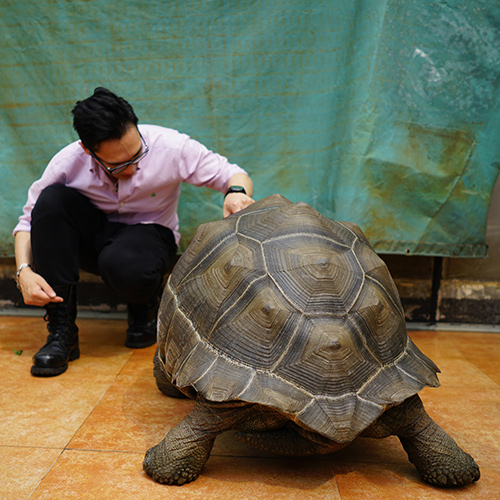
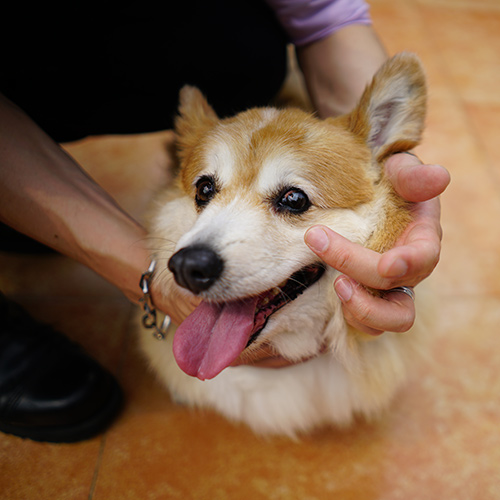
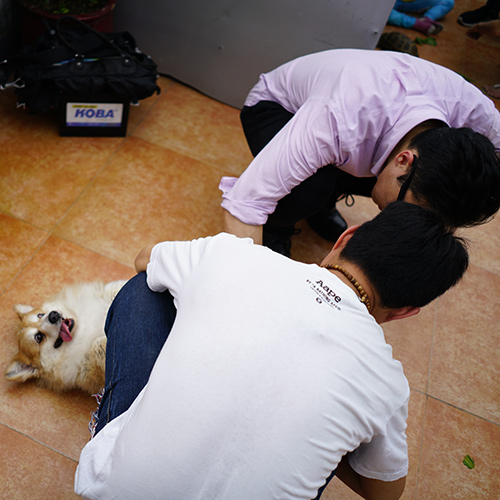
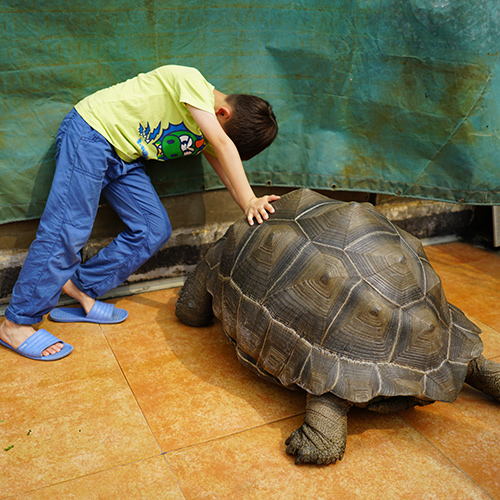
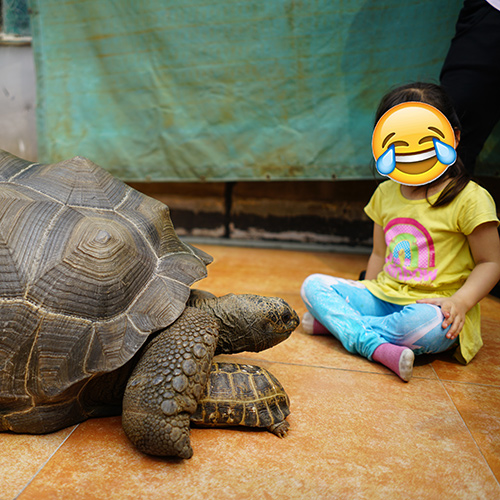

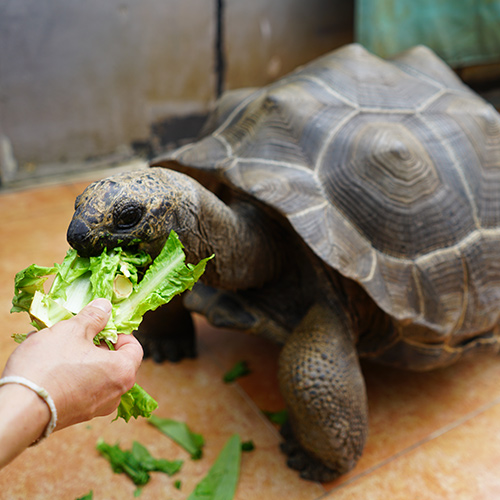
屋企寵物唔舒服? 即時向獸醫查詢
寵物小知識

最近有位狗狗主人問了Jack’s Vet一條很好的問題,關於狗狗絕育,可以跟大家分享:
狗狗主人問:曾聽說狗狗絕育會增加患癌的風險,是真的嗎? 我還應否帶我的小狗去絕育?
這位主人所顧慮的,外國的確有研究報告指出過。美國有多個機構,包括美國獸醫協會(AVMA),都研究過有關狗隻絕育與患癌症的關係。研究報告顯示,經絕育的狗隻比沒有絕育的有更高機會患上不同癌症,包括淋巴瘤和骨肉瘤。那麼還應否替狗狗做絕育呢?
然而這些研究,並不是以正式的臨床研究模式進行。它們在抽樣做調查時,已有偏頗。例如,有些研究只是是根據狗隻主人所填的問卷調查結果做分析;其中一項研究是於當地一所動物醫院找研究個案,過程只找了金毛尋回犬作研究對象,因此研究結果並不泛指所有狗隻品種。再者,去動物醫院裡的動物,大都患有較嚴重疾病,患癌佔其中的大部分,牠們的主人都會更願意花錢在這些患病寵兒身上。因此,在這裡的個案中,患癌症的個案明顯較多。另外,絕育本來是為狗隻避免嚴重疾病,例如子宮積膿、卵巢癌、前列腺癌、睪丸癌等,所以普遍絕育了的狗會有較長壽命。亦因為這樣,狗隻就有更大機會患上跟衰老有關的癌病。另外值得注意的是,金毛尋回犬這品種本身先天容易患上癌症,這是品種基因的問題,所以只以單一品種並在動物醫院進行研究是偏頗的。
現時仍未有確實的證據顯示絕育對狗隻患癌風險有直接關係,反而很多研究都顯示絕育有效延長狗隻壽命。替狗隻絕育,到目前為止仍是利多於弊。
有任何有關絕育的問題? 即時向獸醫查詢
寵物小知識
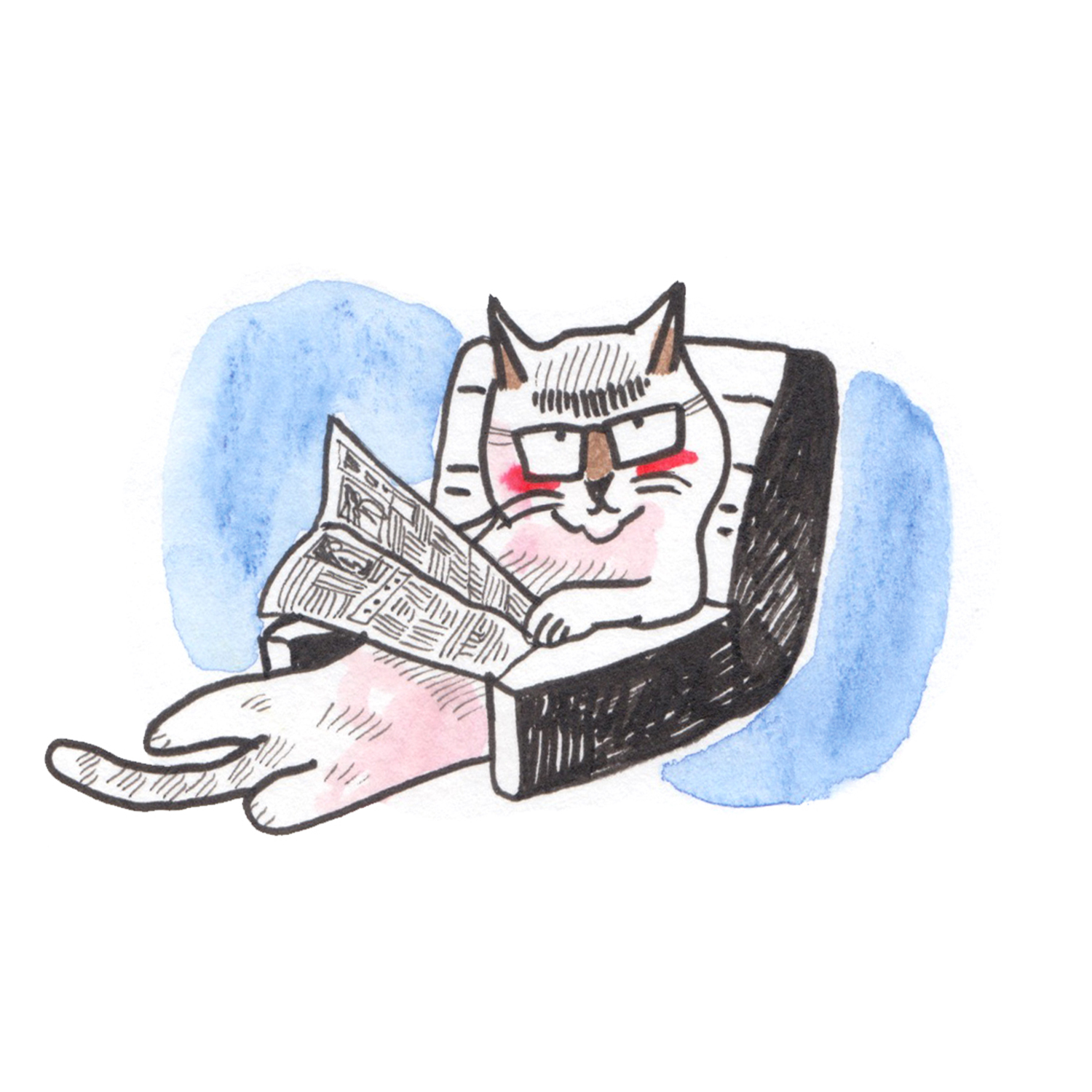
貓需要做運動嗎?
貓確實需要做運動,以保持健康。貓睡很多,在沒有獵物、玩具或其他貓的室內環境會使牠們感到悶,從而變得肥胖。然而,不同的品種有不同的需求。蘇格蘭摺耳和波斯非常懶惰。當我們為貓選擇運動時要知道貓是「短跑者」,意思即是不能進行耐久運動。他們是靠快縮肌肉(fast-twitch fibers)活動,雖然產生的力量大、收縮和放鬆的時間短,但不能長時間活動。所以,你不應該放牠們在跑步機或用帶拖着貓行。你應該為他們提供一些可作攀爬、追逐或隱藏的玩具。例如,攀爬塔、紙盒、紙球、低能量激光束(避免瞄準頭部和眼睛)和一些遙控裝置。
為甚麼我的貓經常盯着我?
當你的貓盯著你,最有可能的原因是「我餓了」。不同於狗,貓是非常獨立的,他們大部分時間都不需要你。從遠處或在貓碗附近的區域盯着你,因為你被認為是食物的來源,他們知道食物是不在你的手。當你走近他們,他們可能會開始喵喵叫或摩擦你的腳。當你漫步到廚房或食物的來源,他們將開始跟著你。
為甚麼我的貓會舔我?
動物行為學家相信貓是會舔其他動物、包括人類,是想表現信賴和關懷。如果你手上有美味的食物,牠們也會舔你。
為甚麼我的貓喜歡躲在箱子裏?
這個問題沒有標準的答案,以下是其中一些解釋
1. 大部份貓都需要深沉的睡眠,所以牠們會找一個安全的狹小空間睡覺
2. 這是貓的本能反應,藏於狹小的空間有助避開狩獵者同時方便偷襲獵物
3. 貓喜歡溫暖,所以喜歡找較為密閉的地方休息
主子有任何異狀? 即時向獸醫查詢

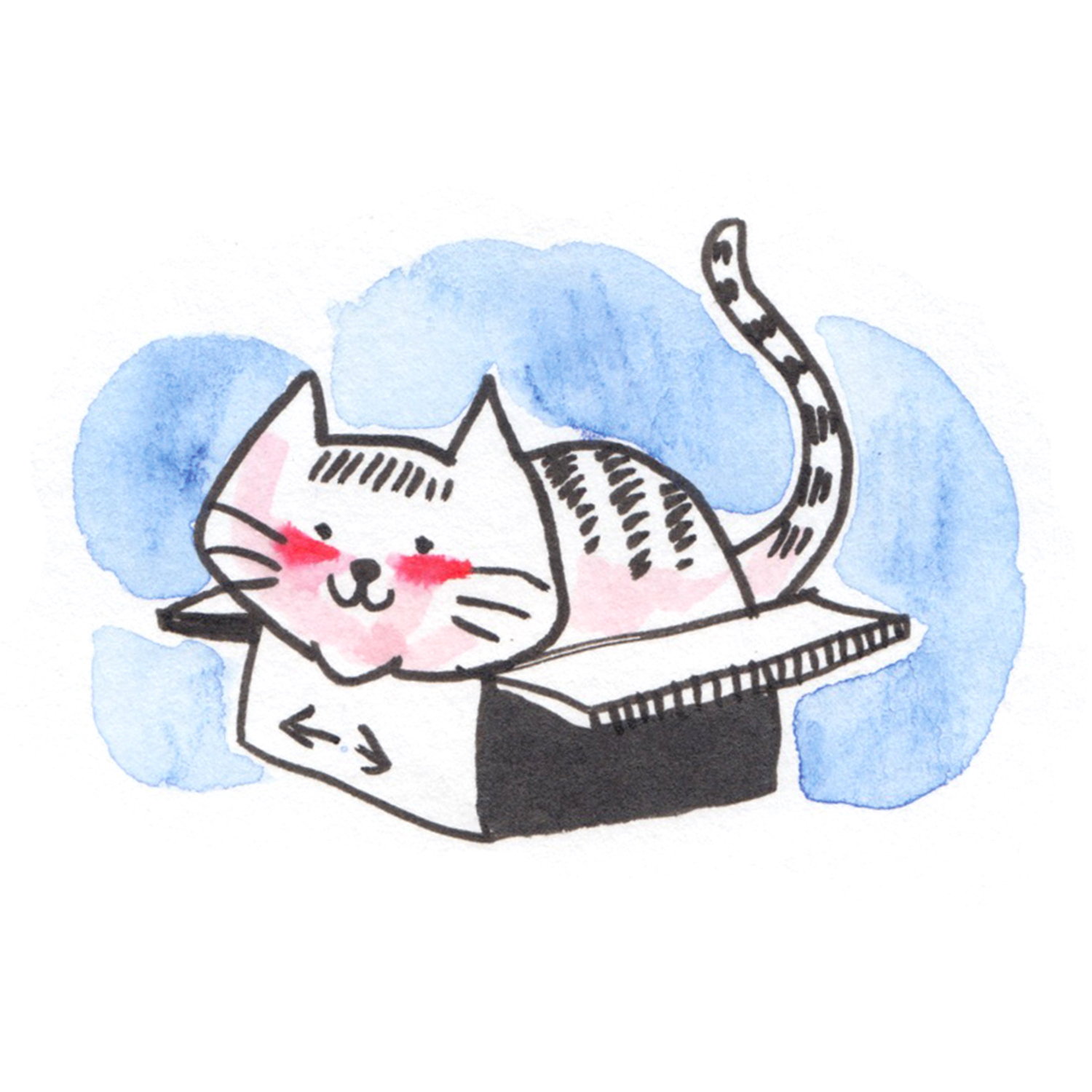
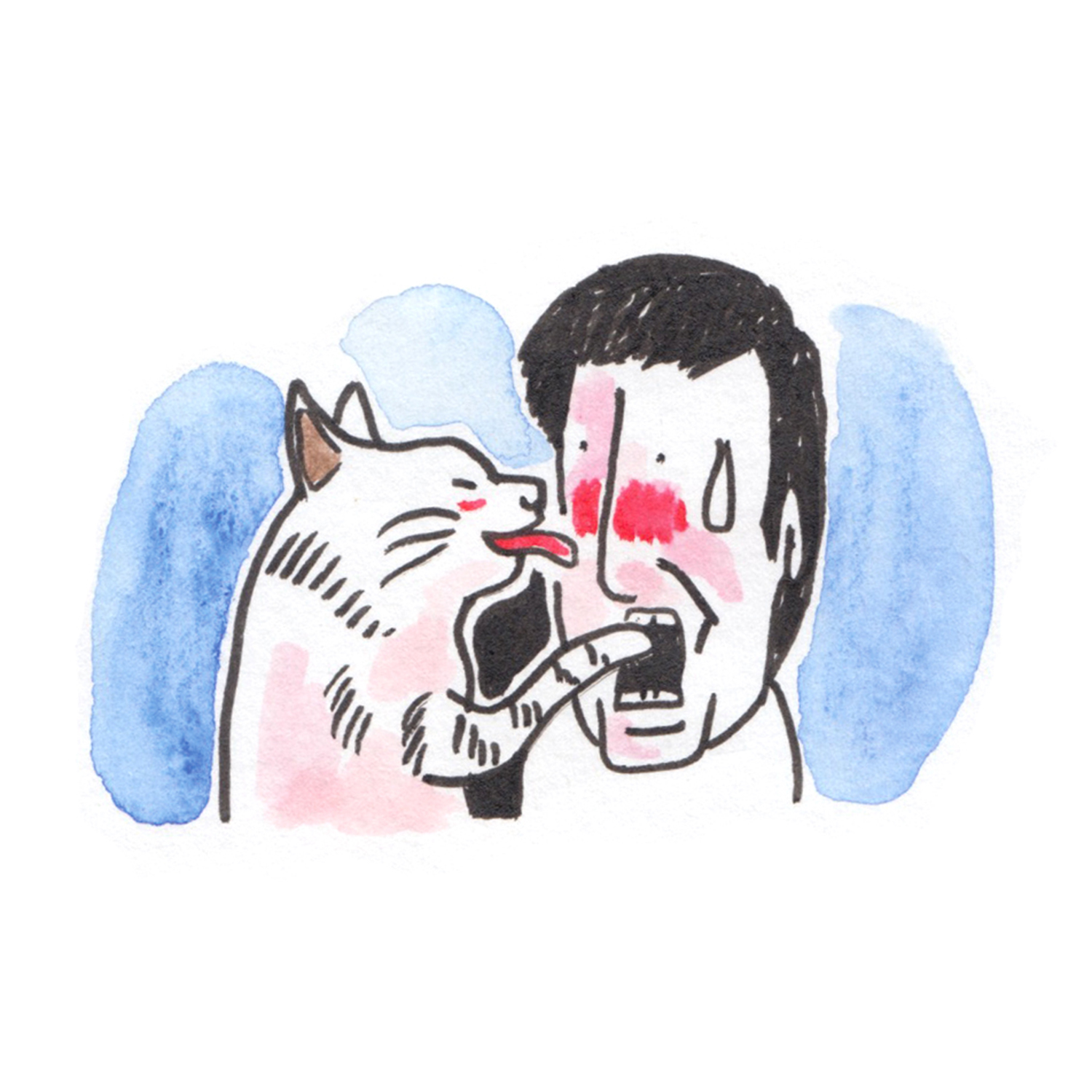
寵物小知識

A good and correct husbandry of aquatic turtles and land tortoises is very important for their health. Incorrect husbandry set-up can cause variety of diseases and health problems such as swelling of eyes, bubbles from nose and loss of appetite. In severe cases, some of them may die even with treatment. The most important requirement of the husbandry is space, correct temperature and light source and water quality. Therefore, I would like to share the correct husbandry set-up for your aquatic turtles and land tortoises here.
Tortoise Husbandry
The enclosure should be at least 2 x 3 sq ft big for a single palm-sized tortoise. This set-up can be achieved by using an all-glass aquarium. It is recommended to use a paper towel or puppy toilet pad as the bedding. Intense basking lamp and UVB lamp should be used for land tortoise. Keep the basking area temperature at 32 – 35 C ( 28 – 30 C for hatching and small sized tortoises ) while measuring from the terrapin shell. The distance between the terrapin shell and the basking lamp should be around 27 cm. The UVB should be set at the same side of the basking lamp. Both basking lamp and UVB should be turned on for 10 – 12 hours daily. The opposite side from the basking area is a cold area where should be at about 25 – 28 C. The different temperature between basking and cold area provides a temperature gradient. You should provide a water bath and food near the basking area and change the water daily. A hiding box or cave should be provided at the cold side. Last but not least, humidity and ventilation are also important. Try to keep the humidity at about 70%. Too low or too high can predispose to respiratory disease. Open top or mesh gives better ventilation.
I hope this illustration and article give you more idea about the correct husbandry set-up and provide a better captive environment for your terrapin and tortoise.
Common Questions
1. Why do we need to put UVB and basking lamp on the same side?
Ans: It mimics what the Sun provides therefore aquatic turtles and tortoises will absorb adequate amount of UVB to meet their metabolic requirement with heat and light together.
2. Is it ok to provide a red or blue basking lamp for my tortoise?
Ans: No, it isn’t. The red or blue basking lamp does nothing to do with heat but just colour. They may use for nocturnal reptiles but not aquatic turtles and tortoises.
3. Why does it need temperature gradient?
Ans: Aquatic turtles and tortoises are cold-blooded animals and which means they take on the temperature of their surroundings. Therefore, temperature gradient avoids them from being over heated or cooled.
4. What substrate does a tortoise need?
Ans: Try not to use bark or sandy substrates because they will cause partial intestinal impaction for hatching or small tortoises resulting in loss of appetite.
5. Why does a tortoise need water bath?
Ans: Ensure adequate amount of water access to prevent urolith or cloacolith formation.
寵物小知識
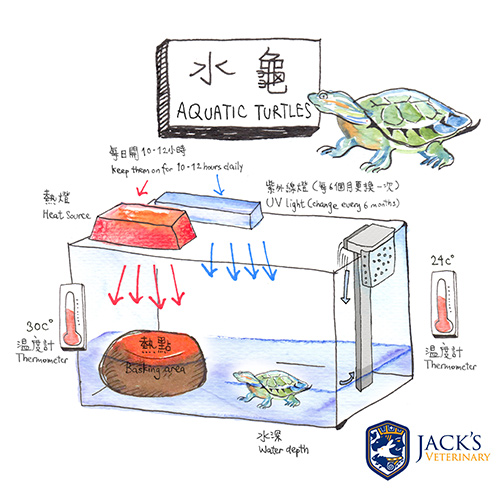
A good and correct husbandry of aquatic turtles and land tortoises is very important for their health. Incorrect husbandry set-up can cause variety of diseases and health problems such as swelling of eyes, bubbles from nose and loss of appetite. In severe cases, some of them may die even with treatment. The most important requirement of the husbandry is space, correct temperature and light source and water quality. Therefore, I would like to share the correct husbandry set-up for your aquatic turtles and land tortoises here.
Aquatic Turtle Husbandry
The aquarium should be at least 2 x 3 sq ft big for a single palm-sized aquatic turtle. This set-up can be achieved by using an all-glass aquarium. An external canister filter should be installed which minimizes water change without compromising water quality. If you do not have a filter system, you should change the water every other day. The depth of the water should be deep enough to cover the whole aquatic turtle and allow them to swim, not walking under the water. You should provide a piece of cork bark or rock as the land and basking area. The heat source should be set above the basking area. Splashproof basking lamp should be used. Keep the basking temperature at 30 – 32 C ( 28 – 30 C for hatching and small sized aquatic turtles ) while measuring from the turtle shell. The distance between the turtle shell and the basking lamp should be around 27 cm and usually the basking temperature is provided. The location of UVB source is very important. It should be set at the same side of basking lamp; therefore, they can receive warmth, light and UVB at the same time. Both basking lamp and UVB should be turned on for 10 – 12 hours daily. The opposite side from the basking area is a cold area where should be at about 25 – 28 C. The different temperature between basking and cold area provides a temperature gradient; therefore, they can choose their preferred temperature to avoid being over heated or cooled. If the size of the tank is not big enough, temperature gradient cannot be set.
I hope this illustration and article give you more idea about the correct husbandry set-up and provide a better captive environment for your terrapin and tortoise.
Common Questions
1. Why do we need to put UVB and basking lamp on the same side?
Ans: It mimics what the Sun provides therefore aquatic turtles and tortoises will absorb adequate amount of UVB to meet their metabolic requirement with heat and light together.
2. Is it ok to provide a red or blue basking lamp for my tortoise?
Ans: No, it isn’t. The red or blue basking lamp does nothing to do with heat but just colour. They may use for nocturnal reptiles but not aquatic turtles and tortoises.
3. Why does it need temperature gradient?
Ans: Aquatic turtles and tortoises are cold-blooded animals and which means they take on the temperature of their surroundings. Therefore, temperature gradient avoids them from being over heated or cooled.
4. What substrate does a tortoise need?
Ans: Try not to use bark or sandy substrates because they will cause partial intestinal impaction for hatching or small tortoises resulting in loss of appetite.
5. Why does a tortoise need water bath?
Ans: Ensure adequate amount of water access to prevent urolith or cloacolith formation.
寵物小知識
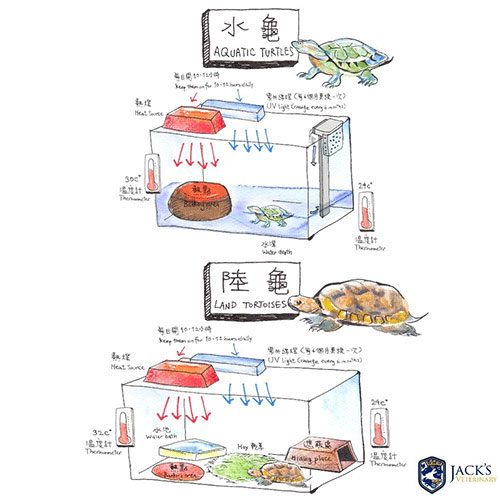
A good and correct husbandry of aquatic turtles and land tortoises is very important for their health. Incorrect husbandry set-up can cause variety of diseases and health problems such as swelling of eyes, bubbles from nose and loss of appetite. In severe cases, some of them may die even with treatment. The most important requirement of the husbandry is space, correct temperature and light source and water quality. Therefore, I would like to share the correct husbandry set-up for your aquatic turtles and land tortoises here.
Aquatic Turtle Husbandry
The aquarium should be at least 2 x 3 sq ft big for a single palm-sized aquatic turtle. This set-up can be achieved by using an all-glass aquarium. An external canister filter should be installed which minimizes water change without compromising water quality. If you do not have a filter system, you should change the water every other day. The depth of the water should be deep enough to cover the whole aquatic turtle and allow them to swim, not walking under the water. You should provide a piece of cork bark or rock as the land and basking area. The heat source should be set above the basking area. Splashproof basking lamp should be used. Keep the basking temperature at 30 – 32 C ( 28 – 30 C for hatching and small sized aquatic turtles ) while measuring from the turtle shell. The distance between the turtle shell and the basking lamp should be around 27 cm and usually the basking temperature is provided. The location of UVB source is very important. It should be set at the same side of basking lamp; therefore, they can receive warmth, light and UVB at the same time. Both basking lamp and UVB should be turned on for 10 – 12 hours daily. The opposite side from the basking area is a cold area where should be at about 25 – 28 C. The different temperature between basking and cold area provides a temperature gradient; therefore, they can choose their preferred temperature to avoid being over heated or cooled. If the size of the tank is not big enough, temperature gradient cannot be set.
Tortoise Husbandry
The enclosure should be at least 2 x 3 sq ft big for a single palm-sized tortoise. This set-up can be achieved by using an all-glass aquarium. It is recommended to use a paper towel or puppy toilet pad as the bedding. Intense basking lamp and UVB lamp should be used for land tortoise. Keep the basking area temperature at 32 – 35 C ( 28 – 30 C for hatching and small sized tortoises ) while measuring from the terrapin shell. The distance between the terrapin shell and the basking lamp should be around 27 cm. The UVB should be set at the same side of the basking lamp. Both basking lamp and UVB should be turned on for 10 – 12 hours daily. The opposite side from the basking area is a cold area where should be at about 25 – 28 C. The different temperature between basking and cold area provides a temperature gradient. You should provide a water bath and food near the basking area and change the water daily. A hiding box or cave should be provided at the cold side. Last but not least, humidity and ventilation are also important. Try to keep the humidity at about 70%. Too low or too high can predispose to respiratory disease. Open top or mesh gives better ventilation.
I hope this illustration and article give you more idea about the correct husbandry set-up and provide a better captive environment for your terrapin and tortoise.
Common Questions
1. Why do we need to put UVB and basking lamp on the same side?
Ans: It mimics what the Sun provides therefore aquatic turtles and tortoises will absorb adequate amount of UVB to meet their metabolic requirement with heat and light together.
2. Is it ok to provide a red or blue basking lamp for my tortoise?
Ans: No, it isn’t. The red or blue basking lamp does nothing to do with heat but just colour. They may use for nocturnal reptiles but not aquatic turtles and tortoises.
3. Why does it need temperature gradient?
Ans: Aquatic turtles and tortoises are cold-blooded animals and which means they take on the temperature of their surroundings. Therefore, temperature gradient avoids them from being over heated or cooled.
4. What substrate does a tortoise need?
Ans: Try not to use bark or sandy substrates because they will cause partial intestinal impaction for hatching or small tortoises resulting in loss of appetite.
5. Why does a tortoise need water bath?
Ans: Ensure adequate amount of water access to prevent urolith or cloacolith formation.
寵物小知識

What is Otitis Externa?
Inflammation of ear canal, otitis externa (OE), is a common reason for doggies to be presented to the veterinarian. To understand the cause of the disease, we need to understand the basic anatomy of their ears. A dog's outer ear consists of the ear flap which can be upright or floppy. The ear canal is long narrow and in L-shape ( vertical and horizontal ) as it travels to ear drum. Some breeds such as poodle and schnauzer have very hairy ear canal. This special conformation of ears allows moist and heat trapped especially with floppy ears. This environment favors yeast and bacteria growth thus predispose to the OE. If OE has not been treated and controlled well, the ear canal epithelium becomes thicker and the lumen will be narrower by time thus more heat and moist being trapped. Eventually, the ear canal is obstructed completely in severe case. Other possible causes of external otitis could be due to food allergy, endocrine disease or immune-mediated disease which also predispose yeast and bacteria growth.
Clinical Signs of Otitis Externa
Clinical signs of OE include headshaking, scratching of ears, warm and redness of the ear flaps. Many owners are able to notice the sign at home. We have more cases during summer time due to the hot and humid weather in Hong Kong.
Treatment of Otitis Externa
To confirm the diagnosis of OE, sampling of ear discharge or wax is necessary. A veterinarian will make a smear on a slide and exam microscopically. Otoscopic examination is sometimes not possible because the ear is painful, swelling and filled with discharge. Sedation may be recommended sometimes. Microbial culture of the ear discharge and radiography of tympanic bullae may require in complicated or severe cases.
Treatment of OE depends on the suspected or known cause of OE. Management of pain and itchiness must be included in the initial treatment plan. Effective treatment may require both topical and systemic antimicrobial therapy along with ear wash and pain relief. If OE becomes chronic and the ear canal eventually obstructed, a surgical procedure is required to remove the vertical part of the canal and allow the horizontal part to be exposed.
Recommendation
Regular ear cleaning is important. It is recommended having your dog's ear cleaned once or twice weekly. As I mentioned above, not all OE in dogs are due to the special conformation of the ears. However, some dogs have primary cause of OE such as food allergy, endocrine or immune-mediated disease. Therefore, visiting veterinarian is important to find out the reason of OE besides trying hard to clean your dog's ears.
寵物小知識
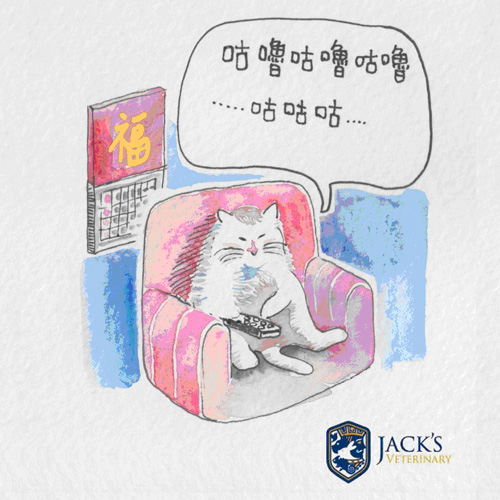
Such an adorable fatty! Every day your cat stays home and enjoys delicious food or falls asleep on its cushioned bed. What a wonderful life you have given to your cat and you are probably really proud of your sweetheart. In fact, you don’t need to pay much care to your cat, as it is able to take care of itself.
Be cautious of this kind of life style! It is time to think if diabetes, which is incurable and irreversible, has been forming in your cat. Here is more information about diabetes in cats. If you own a cat, especially a fat cat, please read the information below carefully before it is too late to regret.
What is Diabetes Mellitus?
Diabetes Mellitus (DM) is a common disease in cats. About 80-85% of DM is noninsulin-dependent diabetes mellitus (NIDDM) which is also called type-2 diabetes mellitus (Type-2 DM). Type-2 DM indicates the situation that cells of such as muscle and liver are unable to absorb blood glucose due to their resistance to the action of insulin; as a result, blood glucose remains in blood stream and the cells are left to starve. When liver cells are starved, they will call the fat cells (adipocytes) to release triglycerides into the blood stream. When triglycerides arrive at the liver, they will be broken down into acetoacetate and to be released into the blood stream where it can be picked up and readily used by other cells and tissues. However, by-product called ketone is also produced during the process. When ketone level is high in blood, it causes acidic blood, electrolyte imbalance and contributes diuresis, which in turn results in hypoperfusion and dehydration. It would also further raise the blood glucose and do the plasma osmolality. Cellular dehydration and thus tissue hypoperfusion would be aggravated. Cats would eventually die from hypoperfusion and dehydration. This is the reason of necessary treatment of DM.
Cause of Type-2 DM
There are many causes of DM and it is usually multifactorial in cats. One of the main causes is obesity. An overloaded fatty acid desensitizes the insulin receptors on cell surfaces. The affected cells thus do not open up the channels for picking up blood glucose. Other reasons such as infection and endocrine diseases are also common.
Cats with DM have quite dramatic symptoms. First, this disease is usually found on a very fat cat with sudden weight loss. They usually tend to eat a lot but they suddenly suffer from a reduction in appetite. Then, they show frequent urination with excessive drinking of water. When the situation is severe, you may see that they walk with toes and hocks flat on the ground. In order to confirm the diagnosis of DM, a blood test and urinalysis is needed to check the presence of glycemia and glucosuria along with the possible symptoms of DM (Polyphagia, Polydipsia, Polyuria and Weight loss etc.).
Treatment of Type-2 DM
Treatment of DM requires hospitalization for several days to rehydrate the cat with intravenous dripping and to find out the correct dosage of insulin for individual cats. Blood glucose curve is a test to adjust the dosage of insulin for cats with DM. Once the correct dosage of insulin is obtained, the veterinarian will usually send the patient home, and let the owner do insulin injections for the cat. Owners need to monitor the patient closely to avoid hypoglycemia which is life threatening. Some veterinarians may show the owner how to use the blood glucose meter at home.
Treatment of DM is a lifelong management instead of giving insulin medication only. Cats with DM require a high fiber diet or prescription diet, on-time insulin injections, some degree of exercise and regular blood test in order to control the DM well. Luckily, in most cases of type-2 DM in cats, it is possible to bring remission if the treatment is managed well. It usually happens within 10 weeks of treatment with absence of complication or any underlying factors of DM.
The first rule to prevent DM in cats is to avoid over-weighting. Cats usually love exercise when young but become very lazy of exercise when they get mature. Try to provide more entertainment at home and control the amount of food given to them before it soon becomes a couch potato. Just move their bums!